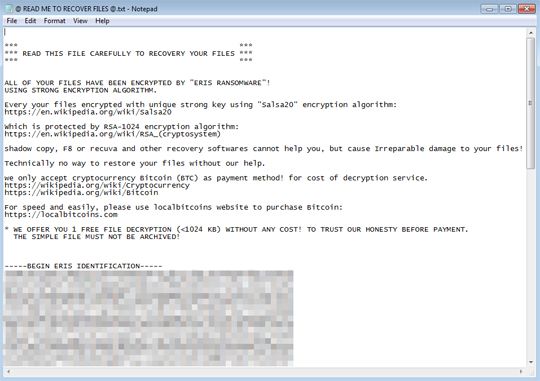Ransom.Win32.ERIS.THGOHAIA
Ransom:Win32/Eris.PA!MTB (Microsoft); RDN/Generic.dx (McAfee); Trojan-Ransom.Win32.Agent.avbn (Kaspersky); Troj/Ransom-FNK (Sophos); Trojan.Win32.Generic!BT (Sunbelt)
Windows


Threat Type: Ransomware
Destructiveness: No
Encrypted: No
In the wild: Yes
OVERVIEW
This Ransomware arrives on a system as a file dropped by other malware or as a file downloaded unknowingly by users when visiting malicious sites.
It deletes itself after execution.
TECHNICAL DETAILS
Arrival Details
This Ransomware arrives on a system as a file dropped by other malware or as a file downloaded unknowingly by users when visiting malicious sites.
Dropping Routine
This Ransomware drops the following files:
- %ProgramData%\00000000.pky → contains public key
- %ProgramData%\00000000.eky → contains encryption key
(Note: %ProgramData% is a version of the Program Files folder where any user on a multi-user computer can make changes to programs. This contains application data for all users. This is usually C:\ProgramData on Windows Vista, 7, 8, 8.1, 2008(64-bit), 2012(64-bit) and 10(64-bit), or C:\Documents and Settings\All Users on Windows Server 2003(32-bit), 2000(32-bit) and XP.)
Other Details
This Ransomware deletes itself after execution.
Ransomware Routine
This Ransomware avoids encrypting files with the following strings in their file name:
- .sys
- .com
- autoexec.bat
- boot.ini
- ntdetect.com
- msdos.sys
- io.sys
- pagefile.sys
- ntuser.dat
- config.sys
- ntldr
It avoids encrypting files found in the following folders:
- windows
- windows.old
- system volume information
- $recycle.bin
- program files
- program files (x86)
- programdata
It appends the following extension to the file name of the encrypted files:
- .ERIS
It leaves text files that serve as ransom notes containing the following text:
- {Encrypted Directory}\@ READ ME TO RECOVER FILES @.txt

SOLUTION
Step 1
Trend Micro Predictive Machine Learning detects and blocks malware at the first sign of its existence, before it executes on your system. When enabled, your Trend Micro product detects this malware under the following machine learning name:
- Troj.Win32.TRX.XXPE50FFF031
Step 2
Before doing any scans, Windows 7, Windows 8, Windows 8.1, and Windows 10 users must disable System Restore to allow full scanning of their computers.
Step 3
Note that not all files, folders, and registry keys and entries are installed on your computer during this malware's/spyware's/grayware's execution. This may be due to incomplete installation or other operating system conditions. If you do not find the same files/folders/registry information, please proceed to the next step.
Step 4
Search and delete these files
- %ProgramData%\00000000.pky
- %ProgramData%\00000000.eky
- {Encrypted Directory}\@ READ ME TO RECOVER FILES @.txt
Step 5
Scan your computer with your Trend Micro product to delete files detected as Ransom.Win32.ERIS.THGOHAIA. If the detected files have already been cleaned, deleted, or quarantined by your Trend Micro product, no further step is required. You may opt to simply delete the quarantined files. Please check the following Trend Micro Support pages for more information:
Step 6
Restore encrypted files from backup.
Did this description help? Tell us how we did.


